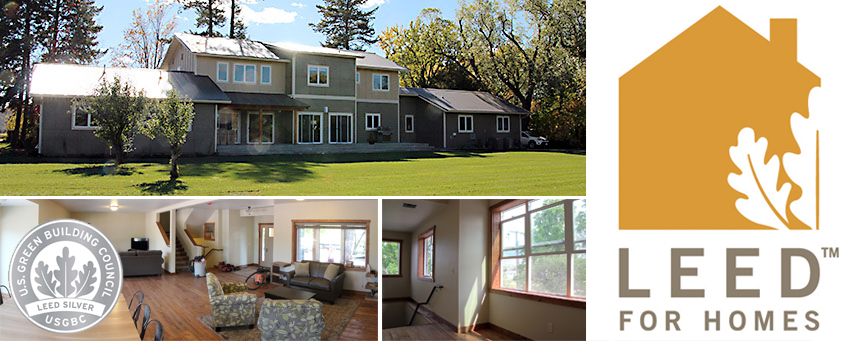LEED™ Certification for our Tom Roy Youth Guidance Home
 z
z
Constructed in 2014, our Tom Roy Youth Guidance Home has been awarded Leadership in Energy and Environmental Design (LEED™) “Silver” status by the U.S. Green Building Council. Designed in a collaborative effort led by Jeff Crouch of CTA Architects Engineers, the new residential home serves the increasing number of kids growing up in our state system without secure adult support in their lives. This thoughtfully designed facility fills the void for kids who don’t have a conventional family. The Tom Roy Youth Guidance Home was designed with an integrated approach that included the youth, the staff, our board, the architect, CTA Architects Engineers, and the builder, Outback Construction, Inc. Together they collaborated in creating a space that addresses the safety, health, educational and environmental needs of the kids, utilizing LEED ™ green building guidelines. This Home will encourage and allow the kids to be more social and self-reliant, while providing them with the best opportunity to grow up as healthy, educated and environmentally aware young people and community members.
The project that evolved over a three-year process highlights some of the best value based sustainability options available to our local market in Missoula, MT. CTA was challenged with delivering a project that would be superior on the sustainability side without adding significant costs to the project. Since the building was replacing an existing dilapidated structure, one of the first goals was to salvage and re-use as much of the existing structure as possible. Local building salvage experts were brought in to remove cabinets, casework, trim, windows, doors and much of the dimensional lumber.
Other key elements of the eventual LEED ™ Silver Certification included the use of local materials including beautiful regionally milled wood floors and exterior fir beam work. Additionally, the Mechanical Engineering team designed a HVAC system including multiple “step-ups” beyond existing local energy codes that resulted in a high level of efficiency as well as higher level of air quality. This strategy incorporated high efficency ERV furnace units and a dual HRV system as well as a Heat-Pump hot water system. Other key sustainability measures included utilization of non-toxic paints, adhesives, carpets and sheet flooring products. The house also scored an impressive HERS rating of 64!
Perhaps the most impactful sustainability measures in the project however, have to do with the residents and the way they interact with their co-habitants and the structure itself. The Tom Roy home houses kids who are high-school aged and are living in the home because they don’t have a functioning “traditional” family to live with. These kids are coming of age and will be “aging-out” of the support system within a few years. Therefore, the entire design of the house was conceived around giving the residents a balance between independent living and social interaction and involvement. The house design created spaces for them to be independent, to study, to have quiet moments of alone time as well as more social interactions. Dining, kitchen and living areas were left open and airy and the more private parts of the house radiate out from this virtual “hearth.” The house also provided them with the ability to interact with the beauty of the surrounding mountains and and the community gardens that sit on the site. (where many of the kids work.) The overarching goal was to provide the residents with a building that creates a sense of respect for them and which feels residential instead of institutional.
To learn more about this unique group home, please contact our Controller, Dann Swallow.
alkdfja
Solor Panels at our Flathead Youth Home
Courtesy of Flathead Electric:
Flathead Electric has launched an innovative new research project to evaluate the impacts of residential solar systems. FEC General Manager Mark Johnson says the project supports the Co-op’s mission to serve as a resource for members by proactively analyzing advancements in the energy industry.
“As solar and other technologies become more widely adopted, it’s important that we understand how they will affect our system, our members and the industry as a whole,” says Johnson.
A team of Flathead Electric employees developed a research strategy which includes the installation and data collection of a net metered solar array and battery backup system that will be analyzed over several years. Rather than installing the system on a family residence, the Co-op conducted an application process to select a local non-profit organization to receive the system (and its associated benefits). The objective was to find a facility with electrical usage similar to a family residence, and the Flathead Youth Home was selected. Program Director Lance Isaak says he is excited about the project, calling it a “win” for all involved.
“Flathead Electric will be able to utilize a well-known facility for research, and we will benefit from savings on electrical expenses and demands, which will help offset the costs of caring for our community’s youth in crisis,” says Isaak. “In addition, we all get to learn more about alternative energy.”
The solar installation at Flathead Youth Home will include a Tesla Powerwall for backup energy storage. Tesla’s leading-edge product has double the battery storage of earlier devices, and, to Flathead Electric’s knowledge, it is the first one installed in Montana.
Johnson says gathering enough relevant data will take several years, which is why he’s taking initiative now. He credits this latest Co-op innovation to: “An exceptionally forward-thinking staff and Board of Trustees.” Read the full article…
Contributors to this project: